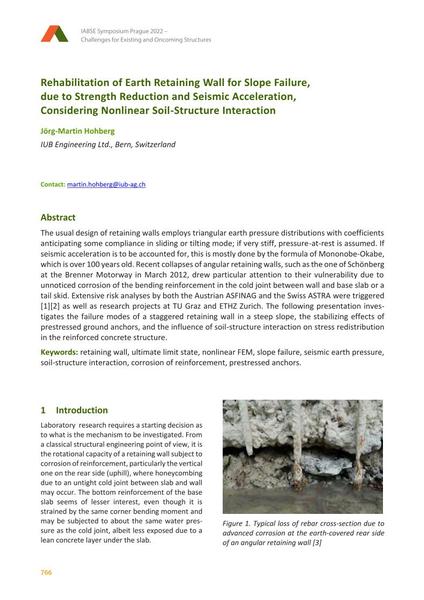Rehabilitation of Earth Retaining Wall for Slope Failure, due to Strength Reduction and Seismic Acceleration, Considering Nonlinear Soil-Structure Interaction

|
|
|||||||||||
Détails bibliographiques
| Auteur(s): |
Jörg-Martin Hohberg
(IUB Engineering Ltd., Bern, Switzerland)
|
||||
|---|---|---|---|---|---|
| Médium: | papier de conférence | ||||
| Langue(s): | anglais | ||||
| Conférence: | IABSE Symposium: Challenges for Existing and Oncoming Structures, Prague, Czech Republic, 25-27 May 2022 | ||||
| Publié dans: | IABSE Symposium Prague 2022 | ||||
|
|||||
| Page(s): | 766-773 | ||||
| Nombre total de pages (du PDF): | 8 | ||||
| DOI: | 10.2749/prague.2022.0766 | ||||
| Abstrait: |
The usual design of retaining walls employs triangular earth pressure distributions with coefficients anticipating some compliance in sliding or tilting mode; if very stiff, pressure-at-rest is assumed. If seismic acceleration is to be accounted for, this is mostly done by the formula of Mononobe-Okabe, which is over 100 years old. Recent collapses of angular retaining walls, such as the one of Schönberg at the Brenner Motorway in March 2012, drew particular attention to their vulnerability due to unnoticed corrosion of the bending reinforcement in the cold joint between wall and base slab or a tail skid. Extensive risk analyses by both the Austrian ASFINAG and the Swiss ASTRA were triggered [1][2] as well as research projects at TU Graz and ETHZ Zurich. The following presentation inves- tigates the failure modes of a staggered retaining wall in a steep slope, the stabilizing effects of prestressed ground anchors, and the influence of soil-structure interaction on stress redistribution in the reinforced concrete structure. |
||||
| Mots-clé: |
mur de retenue
|
||||
| Copyright: | © 2022 International Association for Bridge and Structural Engineering (IABSE) | ||||
| License: | Cette oeuvre ne peut être utilisée sans la permission de l'auteur ou détenteur des droits. |
||||
